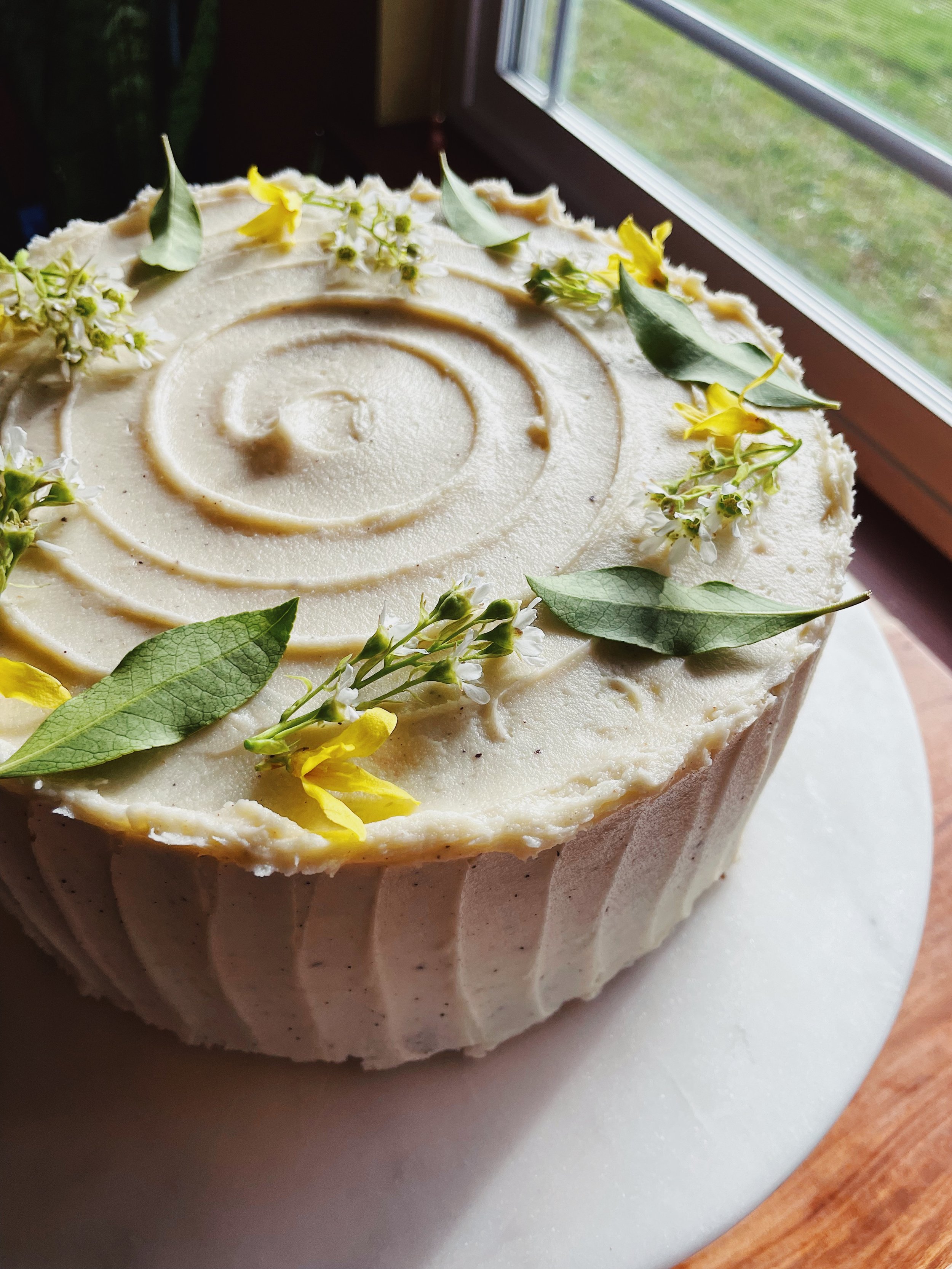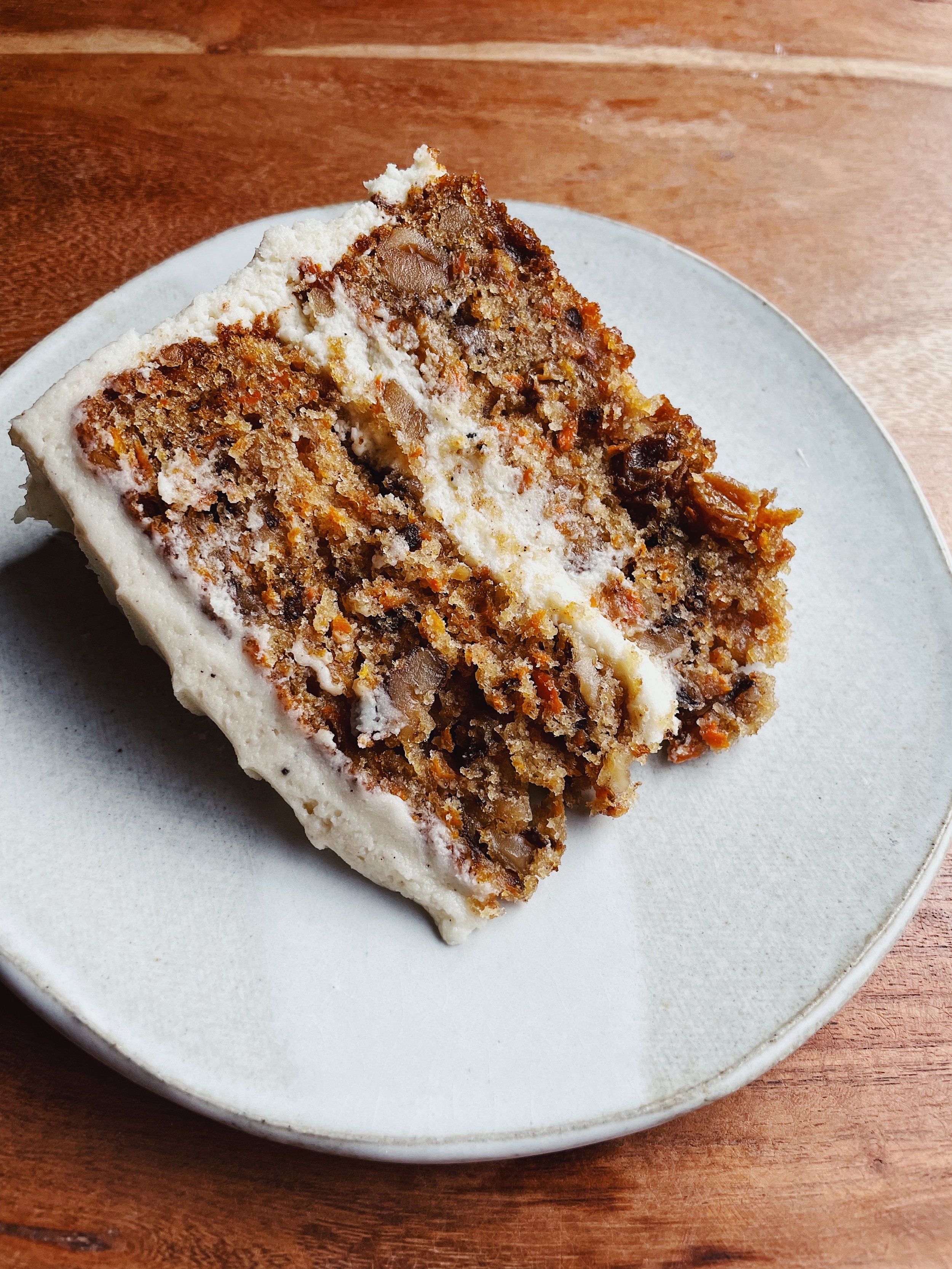Carrot Cake with Browned Butter Cream Cheese Frosting
Easter is this weekend, so I thought I’d share the Carrot Cake with Browned Butter Cream Cheese Frosting recipe from Everyday Cake - in case you’re looking for a winning recipe :)
I learned years ago from the Zoe Bakes blog to coarsely grate your carrots and then finely chop in a food processor for the perfect carrot cake texture. I also add a bit of buttermilk to the batter for a lighter, fluffier crumb (no stodgy cake here!). Spices are cinnamon, ginger, fresh nutmeg, and crushed cardamom; and I fold in toasted walnuts and a blend of golden raisins and tart cherries. As for the frosting, I use browned butter and add the teensiest bit of apple cider vinegar for that much needed tang. You could say this recipe is my platonic ideal - and between Easter and the arrival of spring, it's the perfect time to start baking it 💫
PS Speaking of spring cakes, I shared some of my favorite ones from Everyday Cake with Sur La Table. Head over here to see my selection and to nab the recipes while you’re there!
Carrot Cake with Browned Butter Cream Cheese Frosting
Serves 8 to 10 | Recipe from Everyday Cake
I’ve never come across a more beloved, yet divisive cake. Some folks are purists, eschewing any add-ins. Others are open to inclusions such as nuts, dried fruit, and coconut, but are particular about which ones. I myself am partial to toasted nuts and golden raisins—they add important crunch and bite to an otherwise homogenous texture—but feel free to omit or swap out either ingredient for an equal amount of shredded coconut. As for the icing on the cake, we can all agree that it’s not carrot cake without cream cheese frosting. I’ve taken some liberty and added nutty browned butter. I hope you don’t mind.
Notes (so many!): I prefer the grated carrots to melt into the crumb, instead of poking out in large shreds. To make quick work, shred carrots in a food processor and empty into a bowl. Switch to a blade attachment, add carrots back into the bowl, and pulse a few times until finely chopped. Alternatively, finely grate with a box grater. If you don’t want to put in the effort, coarsely grated will do just fine!
To make this a 4-layer cake, cut each cake layer into two even layers. Increase frosting by 1.5 times.
To make this a regular cream cheese frosting, do not brown butter and proceed with recipe as usual. Swap vinegar out for 1 ½ teaspoons lemon juice.
Ingredients
Cake:
2 ⅔ cups (345 grams) all-purpose flour
1 ½ teaspoons ground cinnamon
1 teaspoon ground ginger
½ teaspoon ground nutmeg
½ teaspoon ground cardamom, cloves, or allspice
2 teaspoons Diamond Crystal kosher salt
1 ½ teaspoons baking powder
1 teaspoon baking soda
1 cup (200 grams) granulated sugar
1 cup plus 2 tablespoons (225 grams) firmly packed light brown sugar
4 large eggs, room temperature
1 ⅓ cup (280 grams) vegetable oil
½ cup (130 grams) buttermilk or plain yogurt, room temperature
1 tablespoon vanilla extract
1 pound (445 grams) finely grated carrots (about 4 lightly packed cups)
1 1/3 cups (140 grams) toasted walnuts or pecans, chopped
1 cup (150 grams) golden raisins, or other dried fruit like tart cherries, chopped dates, or apricots
Frosting:
8 oz (226 grams) unsalted butter
16 oz (445 grams) full-fat cream cheese, room temperature
2 cups (240 grams) confectioners’ sugar
1 ½ teaspoon vanilla extract
½ teaspoon apple cider vinegar
¼ teaspoon Diamond Crystal kosher salt, plus more to taste
2 tablespoons heavy cream or milk
Instructions
To make the cake: Preheat the oven to 350 degrees F. Grease two deep 8- or 9-inch round cake pans and dust the insides lightly with flour.
In a large bowl, whisk together the flour, both sugars, salt, baking powder, cinnamon, ginger, baking soda, nutmeg, and cardamom. Add the eggs, oil, buttermilk, and vanilla and whisk until just combined and smooth. Use a silicone spatula to fold in carrots, walnuts, and raisins.
Divide the batter evenly between the prepared pans and bake, rotating and switching their positions halfway through, until a tester inserted into the centers comes out clean, 40 to 50 minutes for 8-inch pans or 35 to 45 minutes for 9-inch pans. Transfer the pans to a wire rack and allow the cakes to cool completely before assembling.
To make the frosting: First melt the butter in a small saucepan with a light-colored bottom (this will make it easier to check browning) over medium heat. The butter will foam and start to vigorously bubble. Continue cooking at a low simmer, swirling the pan occasionally, until the bubbling subsides and the butter begins to brown and smell nutty. Remove from the heat and allow the butter to keep browning in the pan—the aim is a golden caramel color. Transfer the butter to a shallow bowl and refrigerate until solid.
In the bowl of a stand mixer fitted with the paddle attachment, beat the solidified butter on medium speed until light and fluffy, about 2 minutes. Scrape down the bottom and sides of the bowl, then add the cream cheese, heavy cream, vanilla, vinegar, and salt. Sift in the powdered sugar. Gradually increasing the speed to medium, beat for about 1 minute or until combined. Season with more salt to taste. The frosting can be used immediately or refrigerated for up to 2 weeks—allow it to sit at room temperature for 20 minutes before using.
Assemble: To assemble the cake, place one of the layers (top side up) on a cake stand or plate. Tuck strips of parchment paper under the edge of the cake to keep the plate clean. Top the layer with about 1 cup of the frosting and use an offset spatula to spread it into an even layer. Center the second cake layer (top side down) over the frosted layer and nestle it on top. Using as little frosting as possible, spread a very thin crumb coat over the top and sides of the cake and fill any gaps. If possible, refrigerate the cake for 20 minutes to set it.
Spread the remaining frosting evenly all over the top and sides of the cake. If desired, garnish with nuts or shredded or flaked coconut, depending on the filling. Serve the cake the same day or refrigerate for 2 to 3 days—allow it to come to room temperature before serving.



